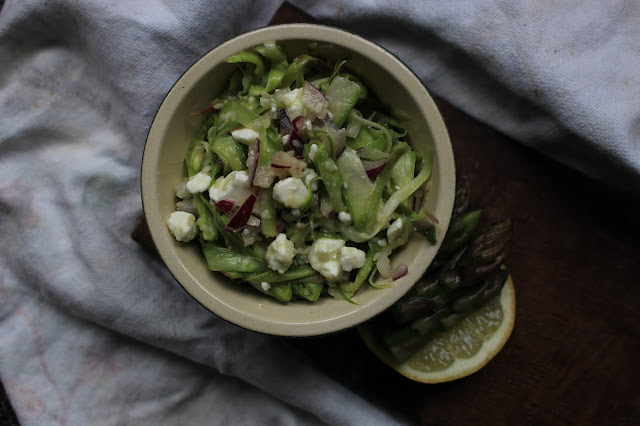One of my favourite memories from living in Kent is when I worked in a local farm kitchen, in the middle of the countryside. It was my job to listen to Classic FM, feed the scraggly cat, and whip up seasonal soups for hungry visitors looking to settle in our glasshouse for a spot of lunch.
Walking down the long lane in the morning, past the newly born lambs and over the hill, I'd come to a small farm with bunches of asparagus and an 'honesty' jam jar on a little table. I'd fill it with my pocketful of coins, scoop up every bunch I could carry, and continue on my merry way.
My asparagus soup was one of my very best, and I'll be sure to share it with you soon (it deserves its own post). When visiting Kent in the spring*, I'm always sure to stock up on asparagus, taking as much as I can on the train home with me. I'm quite firm in the opinion that it's the best of the British offering and, believe me, I've eaten my way through them all.
Perhaps I'm biased, what with my heart belonging to Kent and all, but here's a couple of recipes I've tried out lately.
*I avoid asparagus when it's out of season not just because it doesn't taste the same but because of the water footprint it leaves.
Raw Sesame-Lemon Asparagus Salad
Who said you can't eat asparagus raw? You certainly can and, what's more, it's quite delicious. The above is simply shaved Kentish asparagus tossed with:
- Lemon juice
- Sesame oil
- Chinese rice vinegar
- A pinch of sugar, salt and pepper
- Chopped red onion
- Crumbled feta cheese
I'd also recommend folding through some chopped herbs - dill or chives would work quite nicely.
Hollandaise Sauce
You're looking at my first hollandaise sauce (so long as we forget the time I tried before and curdled it) from chef Matt Sworder at the Corner House Restaurant in Minster, which is where you'll find a sizeable proportion of Kentish asparagus is grown. His restaurant focuses on great local produce and the relationships he has with the farmers in the area, meaning you'll find a menu filled with seasonal dishes hero-ing ingredients grown not far from your table, as well as emphasising traditional British cuisine - think suet puddings, stuffed rabbit, and properly cooked steak and chips.
4 egg yolks
2 spoons lemon juice
220g butter
2 spoons reduction
(For the reduction, reduce 250ml white wine vinegar with 4 peppercorns and a small handful of tarragon stalks)
1. Boil the vinegar together with peppercorns and tarragon, reduce by half. Strain and reserve.
2. Boil a large pan of water, then reduce to a simmer. Using a whisk, beat together the yolks and 2 tsp of the reduced wine vinegar in a heatproof bowl that fits snugly over the pan.
3. Critical step: Beat vigorously until the mixture forms a foam, but make sure that it doesn’t get too hot. To prevent the sauce from overheating, take it on and off the heat while you whisk, scraping around the sides with a spatula.
4. Whisk in a small ladle of the warmed butter, a little at a time, then return the bowl over a gentle heat to cook a little more. Remove from the heat again and whisk in another ladle of butter. Repeat until all the butter is incorporated and you have a texture as thick as mayonnaise. If you're nervous about curdling, just take this process really slowly.
Top tip from The Chef
At the end whisk in a little lemon juice with the seasoning to taste plus a little warm water from the pan if the mixture is a little thick.
Enjoy!


No comments
Post a Comment